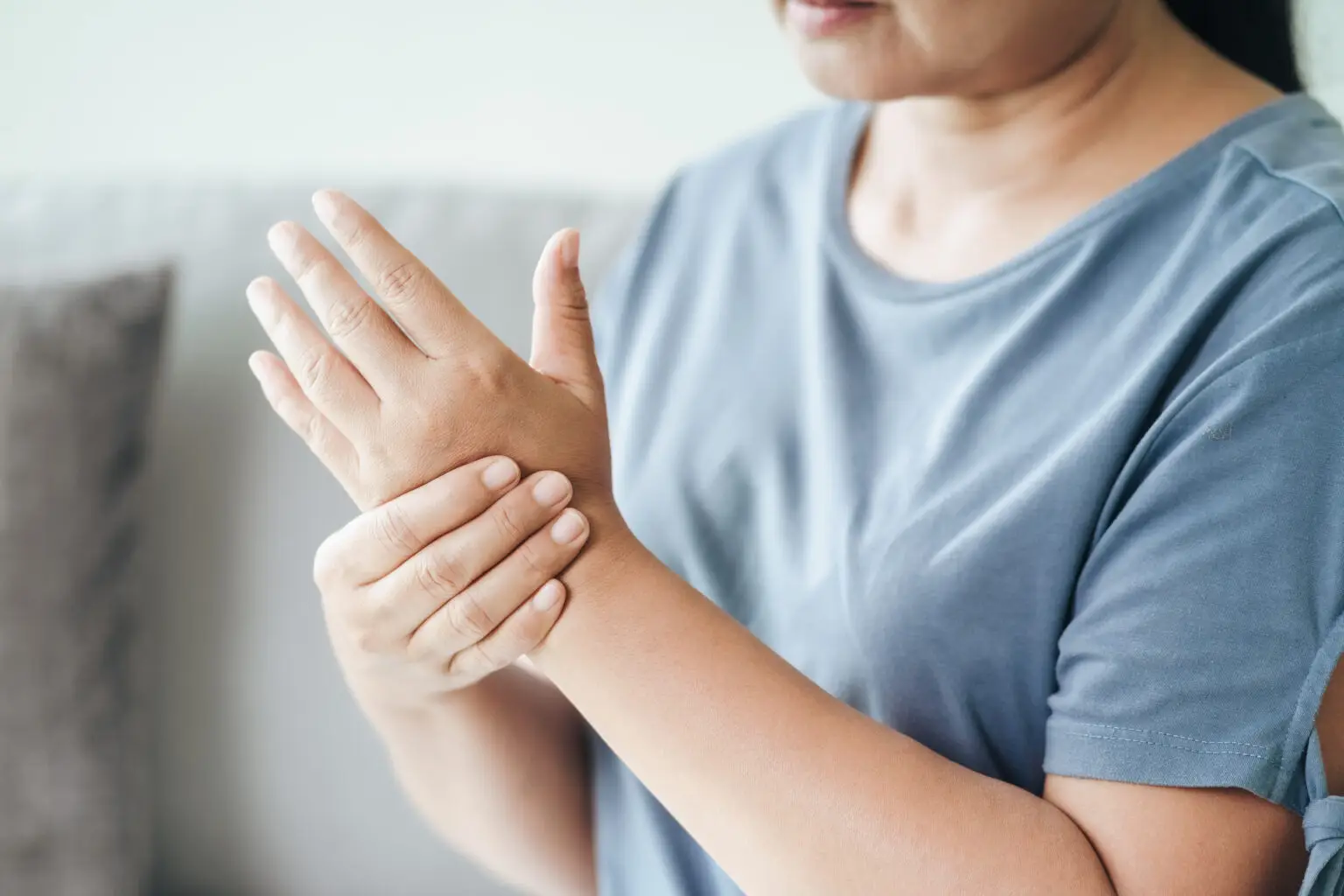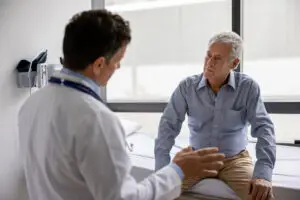A common, but under-discussed symptom of breast cancer treatment is lymphedema. Those who have had their lymph nodes removed or undergone radiation therapy have a higher risk of experiencing long-term lymphedema symptoms. Because there are so few conversations had about this side effect, it can catch patients off guard when it arises. This issue is compounded by the fact that doctors can’t predict which patients will end up developing it.
While lymphedema symptoms can arise during or after any type of cancer treatment, it’s especially common for breast cancer patients. Different studies present a wide range of numbers regarding how many breast cancer patients experience lymphedema, but according to the Journal of Clinical Oncology as many as 83% of breast cancer patients can experience it. Black women are especially likely to develop lymphedema following treatment for breast cancer compared to white women. Black women have a 3.85-fold increased risk.
Lymphedema can present immediately after treatment or can arrive after years, although most cases occur in the first 18 months. To better understand what lymphedema is, what the symptoms are like, and how to treat those symptoms, keep reading.
What is lymphedema?
Lymphedema is a medical condition caused by disruption or damage that occurs to someone’s lymphatic structures (like lymph nodes or lymph vessels). Essentially this system cleans, filters, and processes protein rich fluid. When that fluid becomes stagnant, it can back up and lead to tightness, swelling, and discomfort.
For more extreme cases, fibrosis can occur which is hardening of the tissue, there can be loss of skin integrity that leads to open wounds, and you can lose limb function. Breast cancer patients are more likely to experience swelling in their hands, arms, breasts, and the side of the body they received treatment on.
As lymphedema symptoms advance, the need for treatment can increase and the chance of dangerous complications like bacterial infections that can be life-threatening.
How does breast cancer treatment lead to lymphedema?
The lymphatic system works like a machine and each lymph vessel and lymph node is an integral part of the machine that keeps it working correctly. When you take away or damage a part of a machine, it’s understandable that it may still function but not quite as well as it used to. Each adult has about 600 to 700 lymph nodes in their body, even missing just one can affect the entire system and lead to lymphedema.
Certain breast cancer treatments can lead to damaging or removing parts of the lymphatic system. Here’s a closer look at those treatments.
- Lymph node biopsy. Because breast cancer can spread via the lymphatic system, some patients receive a sentinel node biopsy. This biopsy removes the lymph node closest to the tumor and can involve removing up to six nodes.
- Lymph node dissection. This type of dissection occurs when most or all of the lymph nodes in the armpit are removed when cancer is indicated in lymph nodes through imaging or biopsy.
- Radiation therapy. Because radiation therapy can affect all cells it comes into contact with, this treatment can damage the lymph nodes’ ability to function properly and can create scar tissue in lymph vessels that makes it more difficult for the thick lymph fluid to move along.
What are the signs of lymphedema
How someone’s body reacts to lymphedema can vary, but the following side effects are common. Knowing what side effects to look out for is key so you can alert your care team that you may need to pursue treatment for your lymphedema symptoms.
- Aching. Some people experience a dull ache that comes and goes.
- Heaviness. Your arm or hand might feel heavier than the other side of your body. You may also experience a heaviness or fullness in your breast or around your ribcage on your cancer side
- Tingling or numbness. An early sign of lymphedema is a tingling or numbness anywhere along the affected area—including the armpit
- Non-visible swelling. Swelling can be subtle, so keep an eye out for watches, jewelry, or clothing feeling a bit tighter than normal.
- Itching or tightness of the skin. Skin can look or feel tight or start to itch when swelling occurs.
These symptoms can occur from other causes and don’t guarantee a lymphedema diagnosis, which is another reason why it’s so important to communicate with your care team once you experience one of them.
How to reduce risk and receive treatment
Unfortunately, you can’t fully prevent lymphedema from happening, but you can lower your risk and take steps to reduce the chance of it worsening.
Talk to your doctor and receive regular medical check-ups
First things first, it’s always a good idea to talk to your doctor when you have concerns about your treatment or side effects so you can make a plan together to help you find relief. There are surgical techniques doctors can use to try to lower the risk of lymphedema. There are also ways your doctor can help you after surgery or radiation if symptoms begin to arise.
Receiving regular medical check-ups is a great way to monitor potential signs of lymphedema. Your doctor or a certified lymphedema specialist can measure different areas of your body after you finish treatment to get a baseline to go off. During follow-up visits they can continue these measurements to see if swelling is occurring. The sooner you find signs of lymphedema and start treatment the better.
Don’t be afraid to talk to your doctor if you notice changes in how your body looks or feels.
Exercise and maintain a healthy weight
Exercising not only makes your body stronger and helps it heal after treatment, but using your muscles also helps the lymph fluid circulate and drain properly. Exercising also helps keep your muscles flexible and can reduce scarring.
If you are experiencing lymphedema you can work with a certified lymphedema specialist to design an exercise plan that is right for your unique needs. You can also connect with a physical therapist near you who specializes in working with cancer patients through the American Physical Therapy Association (APTA).
Regular exercise can also help you maintain your weight. Those that are classified as obese experience a higher risk of lymphedema. Your doctor can help you determine what is a healthy weight for your body.
Avoid skin infections, burns, and injuries
When you experience a burn, infection, or injury to the skin, your body responds by sending extra fluid and white blood cells to the area. When missing lymph nodes or when you have damaged nodes, it can be more difficult for your body to move this extra fluid. These difficulties can trigger or worsen lymphedema. It’s especially important to be careful with infections and blood draws. If possible, having blood drawn, IVs, and shots done on the unaffected arm or another unaffected area of the body can help.
Look for signs of cellulitis
Cellulitis, which is an infection that occurs in the tissues directly under your skin can lead to lymphedema. Cellulitis isn’t something you should ignore as it is an urgent medical issue your doctor needs to be aware of. The following signs and symptoms can indicate cellulitis:
- Redness
- Warmth
- Pain
- Cracking or peeling on the skin in the area that’s infected
- Fever
- Flu-like symptoms
Avoid tight and restrictive jewelry and clothing
If tight or restrictive clothing or jewelry squeezes the arm or leg unevenly or too much this can increase pressure in nearby lymph vessels and can lead to increased fluid and swelling. Avoid wearing anything uncomfortably tight.
Wear compression garments
While you’re adapting your wardrobe, you can also add in compression garments such as stockings or fitted sleeves that provide the right amount of pressure to help prevent swelling by moving lymph fluid from the arm or leg back into the body. A lymphedema specialist or doctor can recommend how much pressure is right for you and you will need your compression garments to be custom fitted for your body. Those who already have lymphedema wear compression garments to help feel relief and to minimize side effects.
Air travel can cause lymphedema, so it’s a good idea to wear a compression garment on long flights or even short flights if you fly frequently.
Seek professional help
If you do find you have lymphedema you want to begin treatment as soon as possible to stop the condition from worsening. Again—talk to your doctor about your options. They may recommend you work with a Certified Lymphatic Therapist (CLT) who is usually a physical therapist or occupational therapist who completed a 135+ hour training program for lymphedema care and management. You may also find receiving treatment from a Certified Manual Lymphatic Drainage Therapist (CMLDT) who practices manual lymphatic drainage to be helpful. Your doctor can help you come up with a treatment plan, but it’s also worth doing some research through the Lymphedema Education & Research Network to better understand what your options are.
The takeaway
When left untreated lymphedema can advance and lead to very serious health consequences. Which is why it is so important to monitor potential symptoms after receiving breast cancer treatment or having certain surgeries. There are ways to minimize the discomfort associated with lymphedema and to stop it from getting worse, so talk to your doctor as soon as you suspect there may be an issue.
Tracking symptoms related to your treatment such as those surrounding lymphedema can help your doctor understand their frequency and severity. You can track and manage your symptoms in the Outcomes4Me App and can then bring that data with you to your next doctor’s appointment. Download the app today!



